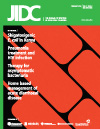Five-year evaluation of the antimicrobial susceptibility patterns of bacteria causing bloodstream infections in Iran
DOI:
https://doi.org/10.3855/jidc.1517Keywords:
bloodstream infections, antimicrobial susceptibility, IranAbstract
Introduction: Bloodstream infections (BSI) are a serious cause of morbidity and mortality worldwide. Emerging antimicrobial drug resistance among bacterial pathogens causing BSI can limit therapeutic options and complicate patient management.
Methodology: To encourage the prudent use of appropriate antibiotics in our pediatric population at Children's Medical Center Hospital, Tehran, Iran, we studied the frequency and antibiogram patterns of blood culture isolates from January 2001 to December 2005.
Results: Of 25,223 blood cultures examined, 2,581 (10.23 %) were positive for bacterial growth. The frequency of Gram-positive bacteria isolated was 47.6% (1228 of 2581) and that for Gram-negatives was 52.4% (1353 of 2581). The rates of methicillin (oxacillin) resistance in Staphylococcus aureus and coagulase-negative staphylococci (CoNS) were 79% and 89%, respectively. About 45% of Streptococcus pneumoniae were resistant to trimethoprim-sulfamethoxazole and approximately 66% to penicillin. Among the Gram-negative isolates, Pseudomonas aeruginosa was most frequently isolated, representing 943 (36.7%) over five years. This possibly represents an unrecognized hospital outbreak or contamination of blood culture bottles or other products such as skin disinfectants. Additionally, this pathogen showed extremely high rates of antimicrobial resistance. There were notable differences in frequency of the five most common microorganisms isolated from blood cultures, which can help set priorities for focused infection control efforts.
Conclusions: Our findings underscore the need to monitor blood culture isolates and their antimicrobial resistance patterns to observe resistance trends that would influence appropriate empiric treatment and infection control strategies for bacteremic children.
Downloads
Published
How to Cite
Issue
Section
License
Authors who publish with this journal agree to the following terms:
- Authors retain copyright and grant the journal right of first publication with the work simultaneously licensed under a Creative Commons Attribution License that allows others to share the work with an acknowledgement of the work's authorship and initial publication in this journal.
- Authors are able to enter into separate, additional contractual arrangements for the non-exclusive distribution of the journal's published version of the work (e.g., post it to an institutional repository or publish it in a book), with an acknowledgement of its initial publication in this journal.
- Authors are permitted and encouraged to post their work online (e.g., in institutional repositories or on their website) prior to and during the submission process, as it can lead to productive exchanges, as well as earlier and greater citation of published work (See The Effect of Open Access).








